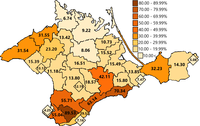Social:De-Tatarization of Crimea
The de-Tatarization of Crimea (Template:Lang-crh; Russian: Детатаризация Крыма, romanized: Detatarizatsiya Kryma; Template:Lang-ukr) refers to the Soviet and Russian efforts to remove traces of the indigenous Crimean Tatar presence from the peninsula. De-Tatarization has been manifested in various ways throughout history, ranging from the full-scale deportation and exile of Crimean Tatars in 1944 to other measures such as the burning of Crimean Tatar books published in the 1920s and toponym renaming.[1]
Manifestations
Topography renaming
The vast majority of districts, raions, villages, and geographic features in Crimea bearing Crimean Tatar names were given Slavic and communist names shortly after the deportation of the Crimean Tatars by the Soviet regime, per a decree of the Crimean Regional Committee mandating such renaming. Most places in Crimea still bear the post-deportation names, many redundant, that were imposed in the 1940s to remove traces of Crimean Tatar existence. Very few localities – Bakhchysarai, Dzhankoy, İşün, Alushta, Alupka, and Saky – were given their original names back after the fall of the Soviet Union.[2][3][4]
Propaganda
Soviet party officials in Crimea indoctrinated the Slavic population of Crimea with Tatarophobia, depicting Crimean Tatars as "traitors", "bourgeoisie", or "counter-revolutionaries", and falsely implying that they were "Mongols" with no historical connection to the Crimean peninsula (despite their Greek, Italian, Armenian, and Gothic roots.)[5] A 1948 conference in Crimea was dedicated to promoting and sharing anti-Crimean-Tatar sentiments.[6]
Amet-khan Airport
The attempts to paint Amet-khan Sultan as a Dagestani contrary to his Crimean origins has faced backlash from the Crimean Tatar community. Despite the flying ace being born in Crimea to a Crimean Tatar mother and always identifying himself as Crimean Tatar, the Russian Federation named a Dagestani Airport after him while naming Crimea's main airport after Ivan Aivazovsky instead, ignoring numerous petitions from the Crimean Tatar community requesting that the airport bearing Amet-khan's name be in his homeland.[7][8][9]
See also
- Russian imperialism
- Ethnic cleansing
- Russification
- Russification of Ukraine
References
Citations
- ↑ Williams 2015, p. 111.
- ↑ Polian, Pavel (2004) (in en). Against Their Will: The History and Geography of Forced Migrations in the USSR. Central European University Press. pp. 152. ISBN 978-963-9241-68-8. https://books.google.com/books?id=8ktrYux1gTMC&pg=PA152.
- ↑ Allworth 1998, p. 14.
- ↑ Bekirova, Gulnara (2005) (in ru). Крым и крымские татары в XIX-XX веках: сборник статей. Moscow. pp. 242. ISBN 9785851670572. OCLC 605030537. https://books.google.com/books?id=VfFoAAAAMAAJ.
- ↑ Williams 2001, p. 29.
- ↑ Williams 2015, p. 114.
- ↑ Williams 2015, p. 105-114, 121-123.
- ↑ Allworth 1998, p. 227.
- ↑ "Добро пожаловать в аэропорт "Амет-Хан Султан" города Симферополя!" (in ru-RU). 2018-11-28. http://milli-firka.org/%d0%b4%d0%be%d0%b1%d1%80%d0%be-%d0%bf%d0%be%d0%b6%d0%b0%d0%bb%d0%be%d0%b2%d0%b0%d1%82%d1%8c-%d0%b2-%d0%b0%d1%8d%d1%80%d0%be%d0%bf%d0%be%d1%80%d1%82-%d0%b0%d0%bc%d0%b5%d1%82-%d1%85%d0%b0%d0%bd/.
Bibliography
- Williams, Brian (2001). The Crimean Tatars: The Diaspora Experience and the Forging of a Nation. Boston: BRILL. ISBN 9004121226. OCLC 803626761. https://books.google.com/books?id=S8YakB12QEUC.
- Williams, Brian (2015). The Crimean Tatars: From Soviet Genocide to Putin's Conquest. New York: Oxford University Press. ISBN 978-0190494711. OCLC 928643532. https://books.google.com/books?id=xabnCwAAQBAJ.
- Allworth, Edward (1998). The Tatars of Crimea: Return to the Homeland: Studies and Documents. London: Duke University Press. ISBN 0822319942. OCLC 799694940. https://books.google.com/books?id=srR_4d3mjTAC.
External links
 |



